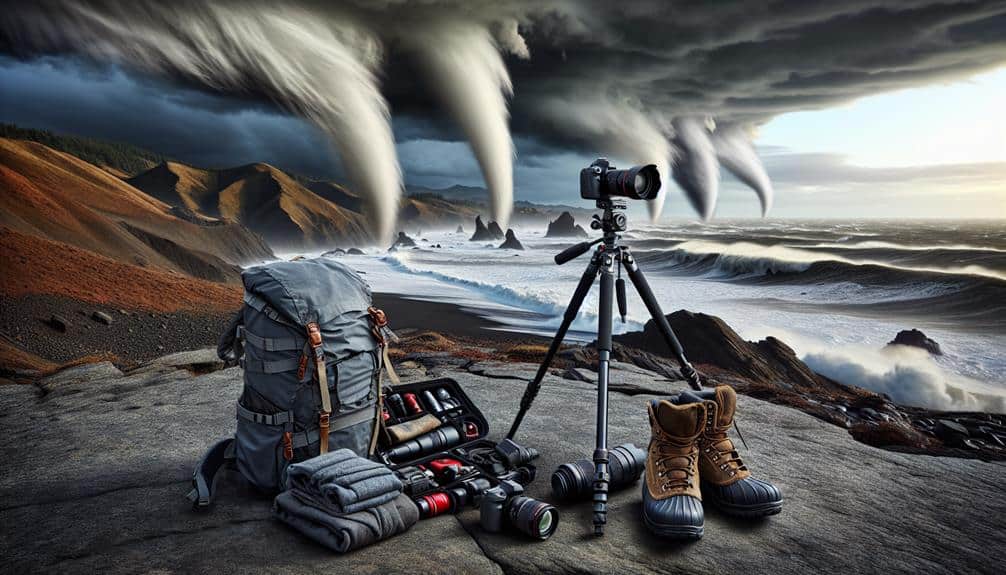When chasing waterspouts, we need to first differentiate between tornadic and fair-weather types, as their formation conditions and risks vary. We should always monitor real-time weather data from reliable sources like the National Weather Service and use equipment such as anemometers and GPS devices. Maintaining a several hundred-meter distance and tracking the waterspout's path in real-time prevent unnecessary risks. Proper safety gear, including helmets and life vests, is non-negotiable. Staying informed through mobile alerts and NOAA updates enables us to adapt quickly to any sudden changes in weather patterns. Discover more nuanced strategies to optimize your waterspout tracking endeavors.
Key Points
- Always maintain a safe distance of several hundred meters from the waterspout.
- Use real-time weather updates and radar imagery to track the waterspout's path.
- Equip yourself with high-definition cameras, GPS devices, and wind speed meters.
- Stay informed through NOAA alerts and local meteorologists for severe weather updates.
Understand Waterspout Types
To safely chase waterspouts, we must first distinguish between two primary types: tornadic and fair-weather waterspouts. Understanding the formation and identifying characteristics of each type is essential. Tornadic waterspouts originate from severe thunderstorms and exhibit similar formation processes to land-based tornadoes. These waterspouts involve intense vertical wind shear and rotating updrafts, making them powerful and potentially hazardous.
Fair-weather waterspouts, conversely, form under much calmer conditions. These typically develop along dark, flat-bottomed cumulus clouds. The formation process begins with a convergence of surface winds that create a rotating column of air over the water, which then extends upward to connect with the cloud base. Unlike their tornadic counterparts, fair-weather waterspouts don't involve severe thunderstorms or significant wind shear.
Identifying characteristics of tornadic waterspouts include a pronounced funnel extending from the cloud base to the water surface, often accompanied by severe weather indicators like lightning and hail.
Fair-weather waterspouts are generally smaller, with a smoother, more translucent funnel and minimal associated weather disturbances.
Monitor Weather Conditions
Monitoring weather conditions is vital for safely chasing waterspouts, as it allows us to anticipate and respond to potential hazards effectively. By leveraging real-time weather updates, we can track the development and movement of waterspouts with precision. Continuous access to meteorological data, such as radar imagery and satellite feeds, allows us to interpret atmospheric conditions accurately.
We must prioritize obtaining accurate weather updates through reliable sources like the National Weather Service (NWS) or specialized storm-chasing apps. Integrating this data with our GPS systems ensures we can make informed decisions on positioning and movement. Advanced weather models and predictive algorithms also play an important role in forecasting the likelihood and intensity of waterspouts.
Safety precautions are non-negotiable. We need to equip ourselves with tools like anemometers to measure wind speeds and barometers to monitor pressure changes. Regularly checking weather updates minimizes the risk of encountering severe weather unexpectedly. Using mobile alerts helps us stay informed about sudden shifts in weather patterns or the issuance of warnings.
Maintain Safe Distance
We must maintain a safe distance of at least several hundred meters from waterspouts to minimize the risk of being caught in their powerful winds and turbulent waters. This distance is essential for employing safe practices, as waterspouts can reach wind speeds exceeding 100 miles per hour, causing significant damage and posing substantial hazards. By staying several hundred meters away, we enhance our ability to conduct effective risk assessment while preserving our freedom to observe these natural phenomena.
Accurate risk assessment involves continuously monitoring the waterspout's trajectory and speed. Utilizing real-time data from weather radars and satellite imagery allows us to predict potential changes in the waterspout's path, ensuring we adjust our position accordingly. It's crucial to avoid complacency; waterspouts can rapidly intensify and alter their course unpredictably.
Maintaining this safe distance empowers us to fully experience the awe of waterspout chasing without compromising our safety. It's not just about the thrill; it's about striking a balance between exhilaration and conscientious observation. By adhering to these safe practices, we can enjoy our pursuit while minimizing risks and ensuring that our adventures remain both exhilarating and secure.
Use Proper Equipment
Equipping ourselves with high-definition cameras, GPS devices, and wind speed meters is fundamental for safely and accurately documenting waterspouts. High-definition cameras allow us to capture detailed visual data, aiding in post-analysis and validation of our observations.
GPS devices are indispensable navigational tools that guarantee we can track our location with precision, minimizing the risks of getting disoriented in rapidly changing weather conditions. Wind speed meters provide real-time data on wind velocities, enabling us to assess the intensity of the waterspout and make informed decisions on maintaining a safe distance.
When combined, these tools enhance our ability to document and analyze waterspouts accurately, contributing to a deeper understanding of these phenomena.
In addition to these technical tools, we must prioritize safety gear. Wearing appropriate protective clothing, such as waterproof jackets and sturdy boots, helps shield us from the elements. Helmets and life vests are essential when operating near water bodies, as they add an extra layer of safety.
Stay Informed and Adaptable

Staying informed about current weather conditions and forecasts is essential for safely chasing waterspouts. We need real-time data and up-to-date information to make informed decisions. This allows us to stay alert to any changes in weather patterns and be prepared for any sudden developments. Our ability to adapt our plans on the fly can make the difference between a thrilling chase and a dangerous situation.
Here are some key steps to stay informed and adaptable:
- Utilize Weather Apps: Use reliable weather apps that offer real-time radar and satellite imagery. This helps us track storm cells and waterspout formations accurately.
- Monitor NOAA Alerts: Regularly check alerts from the National Oceanic and Atmospheric Administration (NOAA) for updates on severe weather conditions and waterspout warnings.
- Engage with Local Meteorologists: Follow local meteorologists on social media for timely insights and updates. Their expertise can provide valuable context to the raw data.
- Use Marine VHF Radios: Equip our vessels with marine VHF radios to receive immediate weather updates and communicate with nearby boats, ensuring we stay informed and connected.
Frequently Asked Questions
What Are the Best Apps for Tracking Waterspouts?
We recommend using apps like RadarScope for detailed weather radar and storm tracking. Combine it with GPS navigation apps like Waze, which provide real-time safety alerts. These tools guarantee precise data and enhance our waterspout tracking experience.
How Can I Identify Safe Locations for Observing Waterspouts?
Sailing through the sea of uncertainties, we evaluate safe locations by analyzing weather conditions and using precise spotting tips. We consider data-driven risk assessments to guarantee our freedom to observe is both exciting and secure.
Are There Specific Times of Year When Waterspouts Are More Common?
We should research waterspout frequency to determine that waterspout formation peaks during late summer and early fall. Data indicates these months provide ideal conditions, maximizing our chances of observing these fascinating phenomena while ensuring our freedom to explore.
What Should I Do if Caught in a Waterspout While on a Boat?
If we find ourselves in a waterspout, it's like being caught in a hurricane's wrath. Initiate emergency protocol immediately. Employ survival techniques: secure yourself, maintain boat stability, and steer away at a 90-degree angle.
Can I Photograph Waterspouts Safely, and What Guidelines Should I Follow?
We can photograph waterspouts safely by following safety guidelines. Ideal locations include coastal regions with frequent occurrences. Guarantee boat safety by maintaining a safe distance and using proper equipment. Always monitor weather updates for real-time data.


